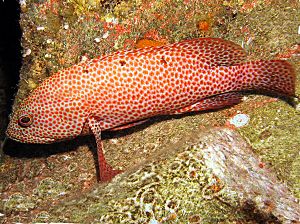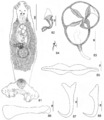Graysby facts for kids
The graysby (Cephalopholis cruentata) is a type of colorful fish that lives in the ocean. It's a kind of grouper, which belongs to a larger family of fish called Serranidae. This family also includes other fish like anthias and sea basses. Graysbies are found in the western part of the Atlantic Ocean. They often live near coral reefs and are caught by both commercial fishermen and people fishing for fun.
Quick facts for kids Graysby |
|
|---|---|
 |
|
| Conservation status | |
| Scientific classification | |
| Synonyms | |
|
Contents
What Does a Graysby Look Like?
The graysby has a strong, oval-shaped body. Its snout is long, and its upper jaw sticks out a little when its mouth is closed. Most of its teeth can move. The top part of its head is flat or slightly curved between its eyes.
Fins and Scales
The fin on its back, called the dorsal fin, has 9 sharp spines and 13 to 15 soft rays. The fin on its belly, the anal fin, has 3 spines and 8 soft rays. The graysby's tail fin is rounded. Its body is covered in rough scales, with 69 to 81 scales along its lateral line.
Colors and Markings
Graysbies can be grey, brown, or olive green. They are covered with orange-brown spots. They usually have four spots along their upper back, right under the dorsal fin. These spots can change color from black to white! A white stripe also runs from its lower jaw, between its eyes, and up to the back of its head.
Size of the Graysby
The longest graysby ever recorded was about 42.6 centimeters (16.8 inches) long. However, they are usually around 20 centimeters (7.9 inches) long. The heaviest graysby found weighed about 1.1 kilograms (2.4 pounds).
Where Do Graysbies Live?
Graysbies live in the western Atlantic Ocean, including the Caribbean Sea and the Gulf of Mexico. You can find them from Cape Fear, North Carolina, and Bermuda, all the way south to the Caribbean coast of South America.
Graysby Habitat and Life
Graysbies live in areas with seagrass beds, like Thalassia, and on coral reefs. In the Gulf of Mexico, they are found on rocky reef ledges in waters deeper than 27 meters (89 feet).
Daily Habits
Graysbies are shy fish that like to be alone. During the day, they usually stay close to places where they can hide. They prefer to stay within a small area, about 2,120 square meters (half an acre), especially during daylight hours.
What Graysbies Eat
Graysbies are hunters that come out at night. Adult graysbies mostly eat other fish, especially a type of fish called Chromis multilineata. Younger graysbies eat shrimp.
Graysby Reproduction and Life Cycle
Graysbies are special because they are protogynous hermaphrodites. This means they all start their lives as females. As they get older, usually around 4 or 5 years old, and when they are about 20 to 23 centimeters (7.9 to 9.1 inches) long, they change into males. This change happens right after they finish spawning (releasing eggs and sperm) in August and September.
Male graysbies protect a group of females, called a harem. On average, one male will guard about six females. When it's time to spawn, a female can release between 260 and 600 eggs. The male then releases his milt (sperm) to fertilize them. Graysbies can live for up to 13 years.
Graysby and People
People catch graysbies for both commercial fishing and for fun. In some places, like Curaçao, graysbies make up about 11% of the fish caught on reefs by commercial fishermen. In the United States, there are rules for catching graysbies. Both commercial and recreational fishing for this species are not allowed from January 1 to April 30 each year.
Images for kids
See also
 In Spanish: Cephalopholis cruentata para niños
In Spanish: Cephalopholis cruentata para niños



